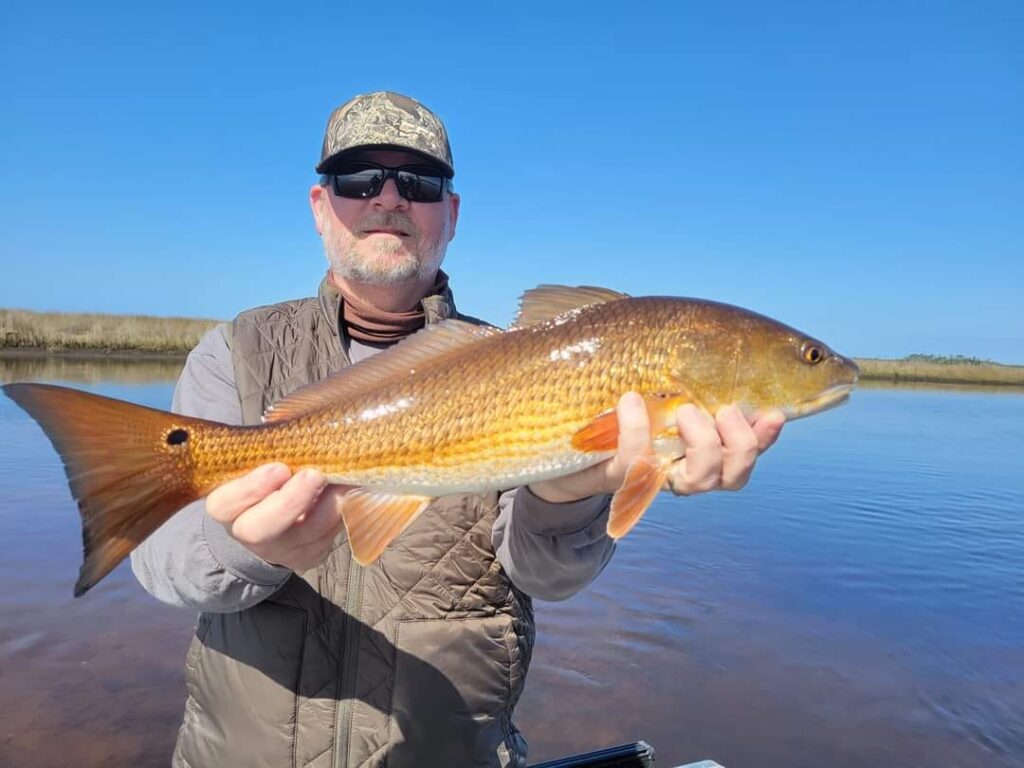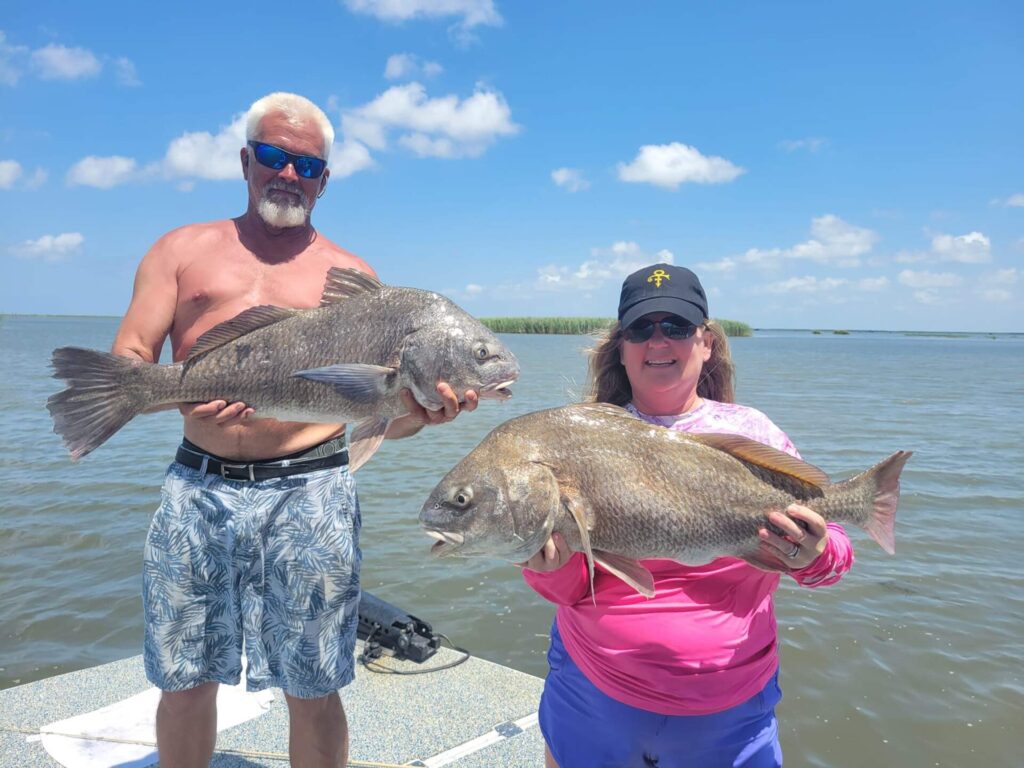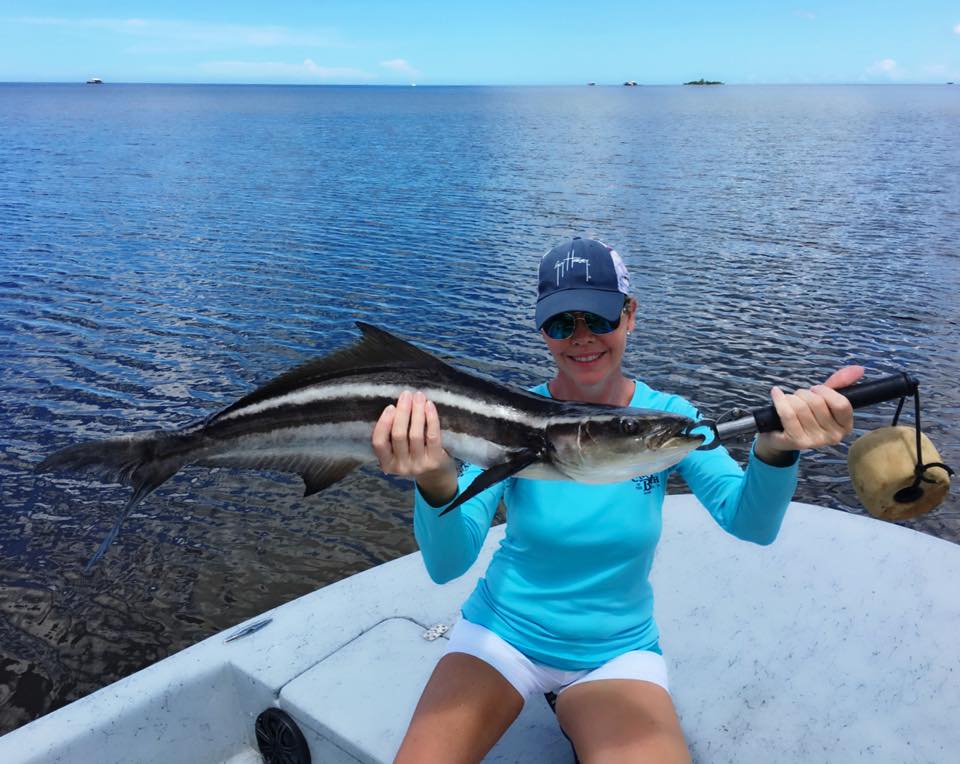If you’re looking for a place where the fish fight hard and the landscape still looks like something out of an old Florida postcard, Econfina Sporting Club is where you want to be. This stretch of the Big Bend is a different breed of Florida—no high-rises, no crowds, just miles of untamed coastline, salt marsh, and winding creeks that haven’t changed much in a hundred years.
If you’re used to fighting for dock space or casting between jet skis, you’ll like it here. When you’re fishing Econfina River it’s just you, the fish, and the kind of water that makes you feel like you’ve got all of Florida to yourself.
Big Bend Game Fish Species (Flats Fishing)
Note: You won’t find largemouth bass on the saltwater flats of Florida’s Big Bend. They’re strictly freshwater fish, so they stick to the rivers, creeks, and backwater systems that feed into the Gulf. Now, if you’re fishing the brackish zones where those rivers meet the Gulf, you might run into striped bass or hybrids, which can tolerate some salinity. They aren’t as common as their freshwater cousins, but they show up in the cooler months when they push down into tidal rivers. So if you’re after great bass fishing in North Florida, stick to the rivers and creeks. If you’re out on the flats, you’re in redfish, trout, and tarpon territory.
Redfish
Redfish are the backbone of this fishery, no question about it. They’re tough, mean, and seem to take personal offense at anything moving too close. They’ll ambush a topwater, crush a spoon, or inhale a live shrimp like it’s their last meal.
They aren’t picky eaters—but they are smart. Get too close, cast too early, or make too much noise, and they’ll disappear like smoke in the wind.

Sight fishing for them out here on the flats is about as pure “Old Florida” as it gets—watching that copper body ghost out of the grass, tracking your lure with bad intentions before hammering it like it owes him money. And once he’s on, he’s going to test everything—your drag, your knots, maybe your patience. If you like a fight, you’ll like redfish.
Around Econfina, stick to the oyster bars, grass flats, and creek mouths when the tide is moving, and you’ll find them. Low tide? Look for them tailing in the shallows, backs and fins breaking the surface as they root for crabs and shrimp.
Speckled Sea Trout
Trout are a little more refined compared to their brawler cousins, the redfish. They’re still aggressive, but they like a little finesse. These fish love a topwater plug at first light, when the water is glassy, and the air is still carrying a little of that nighttime cool. But as the day heats up, they shift gears. You’ll do better with soft plastics, paddle tails, or live bait drifted over the grass flats.
Finding trout isn’t the hard part—they’re all over the place. The real trick is finding the big ones. The little guys will hit just about anything, but those gators—the 25-inch-plus heavyweights—play by different rules. They tend to hang deeper, on the edges of drop-offs, or right at the transition between sand and grass.
They’re also a little lazier. They like a slow, easy meal. Big trout are ambush predators, so think like one—slow your retrieve, work your lure with patience, and be ready when that big yellow mouth opens up to inhale it.
Around Econfina, the best trout fishing on the flats happens on a moving tide, especially an incoming one when baitfish are pushed over the flats. If you’re not finding them in the usual spots, check around creek mouths, sandbars, and channels where cooler water flows. And when you finally hook into one of those gators, you’ll know it—because for a second, you’ll think you hooked into something much bigger.
Black Drum
Black drum aren’t exactly the supermodels of the fish world, but they make up for their looks with raw, unfiltered power. They run in schools, and when you stumble onto one, you’ll know it—because suddenly, your rod is bent double, your drag is screaming, and you’re locked into a battle that feels more like hauling a cinder block off the bottom than fighting a fish.
The smaller ones, around 3 to 5 pounds, are scrappy and fun. The big boys? They’ll test everything you’ve got—from your knots to your backbone.
They eat crustaceans almost exclusively—shrimp, crabs, anything they can root up off the bottom—so if you’re a fan of soaking bait around oyster bars, dock pilings, or deeper channels with some structure, you’re in the right place. Live or dead bait works, but if you really want to get their attention, cut bait on the bottom is the way to go. When they take the bait, don’t rush it—black drum have that methodical, bulldozer-like pull that rewards patience and punishes hesitation.

Out here in the Big Bend, you’ll find them stacked up in the shallows in cooler months, especially in those deep holes and muddy bottoms that hold heat. When the water warms up, they spread out more, moving through passes and deeper flats.
he fight is a marathon, not a sprint, and if you land one of the big ones—30, 40 pounds or more—you’ll walk away with a sore arm and a new level of respect. A lot of Northern Florida fishermen say the little ones make for some of the best eating in the water, but the big bulls? Let ‘em go. They’re best kept here, to keep making more black drum.
Sheepshead
These sneaky, sharp-eyed fish are notorious bait thieves, armed with a mouth full of human-looking teeth—an unsettling sight if you’ve never seen one up close. They use those chompers to scrape barnacles off pilings, crush crustaceans, and make a fool out of anyone who isn’t paying attention.
Sheepshead are really structure-oriented fish. They don’t roam the open flats like redfish or trout—they’d rather stick tight to docks, bridge pilings, oyster bars, and rock piles. If you’re not fishing around something hard and encrusted with life, you’re not where the sheepshead are.
The trick is getting a bait down to them without alerting the whole school. A well-presented fiddler crab, live shrimp, or even a chunk of barnacle-covered shell will get their attention—but don’t expect them to make it easy for you.
The bite is so subtle it’ll drive you crazy. One second your bait is there, the next it’s gone, and all you felt was a whisper of resistance. Setting the hook on a sheepshead is part skill, part guesswork, and part pure luck. But when you do stick one, you’ll know it. They fight way harder than their size suggests, making quick, bulldogging runs back toward structure.
Sheepshead aren’t the easiest fish to catch, but that’s what makes them worth targeting. If you’re the kind of guy who enjoys a challenge, tying into a sheepshead will test your patience, your reflexes, and your ability to keep your cool when you miss bite after bite. And trust me, you will miss plenty.
Cobia

Cobia are a wild card. You might see them cruising the flats, shadowing a stingray, or just show up in a place you wouldn’t expect. When they do, you’d better be ready.
They’re curious by nature, and that curiosity can be their downfall—if you’re quick enough. These fish will charge down a well-placed live bait, a flashy jig, or even a topwater plug if they’re feeling aggressive.
Hook one, and you’re in for a ride—long, blistering runs, head-shaking chaos, and a fight that doesn’t play out in a straight line. They’ll bulldog straight for deeper water, test your gear, and if you’re lucky, even put on an aerial show.
Out here in the Big Bend, cobia aren’t a sure thing on flats fishing trips, but that’s what makes them fun. Not everyone gets the chance to catch a cobia on the flats, but if you do, you won’t forget it.
Tarpon
Tarpon are the undisputed kings of this place, and they don’t care one bit if you’re ready for them or not. If you want to feel truly outmatched in the best way possible, try hooking into a tarpon in just a few feet of water and see how quickly your plans fall apart.
The second that hook sets, they’re airborne—gills rattling like a box of loose ammo, twisting, thrashing, doing everything in their power to throw the hook before you even get your bearings. Some guys land them, some don’t, and that’s just the way it is.
These fish are ghosts until they aren’t, showing up when they feel like it, usually in the warmer months. But when they do, everything else takes a back seat. The only thing that matters in that moment is keeping them on long enough to call it a fight—because win or lose, that’s exactly what it’ll be.
The Takeaway
If you’re the kind of fisherman who likes to drop the line in the water and take a nap while waiting for something to happen, these probably aren’t your kind of waters. But if you thrive on the chase, if you like figuring out a pattern, working structure, reading tides, and putting in the time to hook something that’ll make you earn every inch of line—then Florida’s Big Bend is exactly where you need to be.
And that’s the fun of it. That’s why you come here. The fights are real, the rewards are earned, and the whole experience is the kind you tell stories about for years.
So come out to Econfina Sporting Club, North Florida’s luxury hunting & fishing lodge, pour yourself a drink, swap a few war stories, and get ready to go again tomorrow—because these waters always have something more to give, if you’re willing to work for it.


